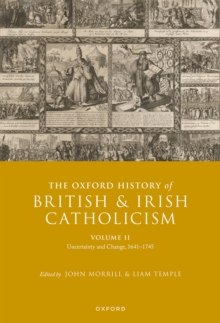
The Oxford History of British and Irish Catholicism, Volume IV : Building Identity, 1830-1913 EPUB
Edited by Carmen M. Mangion, Susan O'Brien
Part of the Oxford History of British and Irish Catholicism series
EPUB
Description
After 1830 Catholicism in Britain and Ireland was practised and experienced within an increasingly secure Church that was able to build a national presence and public identity. With the passage of the Catholic Relief Act (Catholic Emancipation) in 1829 came civil rights for the United Kingdom's Catholics, which in turn gave Catholic organisations the opportunity to carve out a place in civil society within Britain and its empire.
This Catholic revival saw both astrengthening of central authority structures in Rome, (creating a more unified transnational spiritual empire with the person of the Pope as its centre), and a reinvigoration at the local and popular level through intensified sacramental, devotional, and communal practices. After the 1840s, Catholicsin Britain and Ireland not only had much in common as a consequence of the Church's global drive for renewal, but the development of a shared Catholic culture across the two islands was deepened by the large-scale migration from Ireland to many parts of Britain following the Great Famine of 1845.
Yet at the same time as this push towards a degree of unity and uniformity occurred, there were forces which powerfully differentiated Catholicism on either side of the Irish Sea.
Four very differentreligious configurations of religious majorities and minorities had evolved since the sixteenth-century Reformation in England, Ireland, Scotland, and Wales.
Each had its own dynamic of faith and national identity and Catholicism had played a vital role in all of them, either as 'other' or, (in thecase of Ireland), as the majority's 'self'. Identities of religion, nation, and empire, and the intersection between them, lie at the heart of this volume.
They are unpacked in detail in thematic chapters which explore the shared Catholic identity that was built between 1830 and 1913 and the ways in which that identity was differentiated by social class, gender and, above all, nation.
Taken together, these chapters show how Catholicism was integral to the history of the United Kingdom in thisperiod.
Information
-
Download - Immediately Available
- Format:EPUB
- Pages:352 pages
- Publisher:OUP Oxford
- Publication Date:01/09/2023
- Category:
- ISBN:9780192587541
Information
-
Download - Immediately Available
- Format:EPUB
- Pages:352 pages
- Publisher:OUP Oxford
- Publication Date:01/09/2023
- Category:
- ISBN:9780192587541










